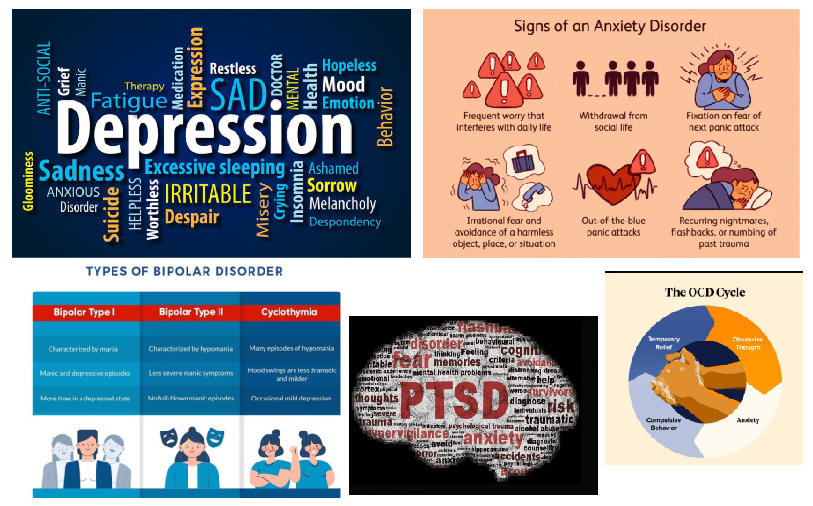People with mental health disorders, sometimes known as mental illnesses, experience changes in their thoughts, feelings, and behaviours. Mental health disorders, including depression and anxiety, can be influenced by lifestyle factors such as diet, substance use, and daily habits. While genetic links are still under study, these factors significantly impact mental well-being.
Mental disorders, whether intermittent or persistent, can impact an individual’s ability to connect with others and perform daily tasks. Though certain illnesses are more severe than others and may require short-term or long-term professional care, there are strategies to improve overall mental health.
The following are the five most common mental health problems, along with their associated symptoms. In general, if you suspect you have a mental health condition, you should contact a mental health specialist.
 What is a Mental Health Disorder?
What is a Mental Health Disorder?Mental health conditions, sometimes referred to as mental illnesses, affect your thoughts and actions. They can alter your mood and hinder functioning at work, school, or home. Having a behavioral health condition does not necessarily mean experiencing poor mental health at all times. You may suffer from behavioural health disorder and still can go through long periods of good mental health status.
Mental health conditions like anxiety and depression have an impact on our thoughts, emotions, and behaviour. More than 200 different kinds of mental diseases exist. Treatment for mental health conditions, which may involve medication, psychotherapy, alternative therapies, or brain stimulation therapy, typically results in an improvement in symptoms.
Read Also: Factors to Consider While Choosing the Best Rehab Center in Hyderabad
Understanding the problem is the first step toward resolving it. Learn more about most common mental disorders below:
Anxiety is one of the most common mental diseases in the world. According to the Anxiety & Depression Association of America, children are also affected by this mental disorder; 7.1% of kids between the ages of 3 and 17 have been diagnosed with anxiety. Numerous anxiety disorders can be categorised under the general word "anxiety," such as:
Read Also: Multiple Sclerosis Treatment in Hyderabad
Another prevalent mental illness is depression. Similar to anxiety, depression is a general term that encompasses a variety of conditions, such as:
Read Also: Best Hospital for Brain Stroke Treatment in Hyderabad, India
Bipolar disorder symptoms usually appear in your twenties, however they can sometimes appear later in life. Manic depression is another name for this mental condition. Extreme mood swings that go back and forth are experienced by people with bipolar disorder. A person with bipolar disorder may feel incredibly confident and energised during a manic episode. They might also act rashly and impulsively. Bipolar disorder sufferers may also go through depressive episodes during which they feel hopeless, depressed, and lethargic. It is normal to switch between these two severe moods, interspersed with stable times.
One of the most common mental health conditions is post-traumatic stress disorder (PTSD). Trauma can lead to the development of PTSD. Anyone who experiences trauma can get PTSD, even though it is a common mental health condition among soldiers. Approximately 15 million adults suffer from PTSD. Although symptoms might appear months or even years after the initial incident, PTSD is usually diagnosed when a person has symptoms for more than a month after the event. PTSD side symptoms include:
Approximately one-third of those with an OCD diagnosis initially exhibit symptoms as children. OCD often appears as obsessive cleaning. Though the symptoms of OCD vary from person to person, this might undoubtedly be one of them. Anxiety-inducing obsessive thoughts and imagery are common in OCD sufferers. Even if you acknowledge that these compulsive ideas are harmful, you may still find it difficult to stop them. Common obsessive thoughts include intrusive thinking about particular phrases and images, dread of contamination, and worry of losing possessions. Another sign of OCD is compulsions. To relieve anxiety brought on by obsessive thoughts, an OCD sufferer may feel driven to engage in repetitive behaviours.
By using cutting-edge technology and leveraging data to guide our approach, our team of medical professionals at Walk Again crafts customized treatment plans that evolve with each patient’s journey toward recovery. This personalized strategy ensures that we are not only addressing the unique challenges and severity of each case but also achieving tangible, measurable improvements in their health.
At Walk Again in Hyderabad, we provide cutting-edge, personalized treatments for mental illnesses, integrating holistic approaches like yoga and mindfulness, counselling, medicine, and therapies like cognitive behavioural therapy. The city promotes mental health and long-term healing with qualified specialists and individualised care.
Behavioral health issues can impact thoughts, emotions, and behavior, but effective treatments can pave the way for a healthier, more balanced life. They may make it challenging to perform at work, school, or home. However, there are solutions. The first step in treating a mental health illness is receiving a precise diagnosis. If you or your kid exhibit any of these symptoms, speak with your doctor.
If you are looking for the right mental care for you or your loved ones to reestablish the independence of life, then get in touch with our psychiatrists at Walk Again, the best hospital for mental disorder treatment in India. Book your consultation now!
Q1:What are the symptoms of anxiety disorders?
A: Symptoms include excessive worry, restlessness, rapid heartbeat, and difficulty concentrating.
Q2: How is depression different from regular sadness?
A: Depression is more intense, long-lasting, and often accompanied by fatigue, hopelessness, and physical symptoms like sleep disturbances.
Q3: What causes bipolar disorder?
A: It’s caused by a mix of genetic, environmental, and neurological factors, often triggered by stress or significant life changes.